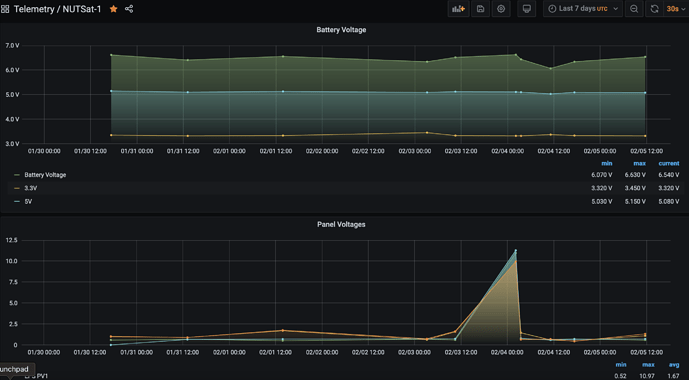Regarding Observation 7112778 …
The current battery voltage of the NUTSat Cubesat is low, I am very grateful if you can assist in the observation!!
vy 73!
Randson /BV2DQ/ WJ2I
Taipei, Taiwan.
“I am very grateful if you can assist in the observation!!”
By this you mean, you would like to have some observation done via the SatNOGS network?
Please share some information:
- Where will the satellites be active (location)?
- What mode will it use 1k2 AFSK AX.25 or 9k6 FSK G3RUH?
- What frequency do we need to monitor, 145.825 or 436.850?
This will help in successful observations.
Can you share what the voice message is telling us, listening to the observation you shared.
Dear Jan…
Thanks for your help.
The NUTSat it in active since 29th Dec 2022, but only UHF(Dipole ant) 435.850MHz 1200bps AX.25 beacon received. Due to power lower than to 6.5V(full 8.4v, 2S2P 18650 batteries), only two of the four solar panels wings have been turned on(it covers the VHF Dipole antenna). After we send uplink command to try open solar panels again this week. it seems show the solar panels they are all turned on.
The battery voltage is too low and the GPS and ADS-B receiver functions are disabled.
The NUTSat also carry Digipeater function on 145.825MH/1200bps APRS standard protocol, but so far we didn’t find the beacon (every 300 second), The transmit RF power 1w/0.5w depend on 7.4v volts threshold!
I appreciate if can help to monitor for UHF/VHF dual band, and welcome to test for VHF APRS Digipeater.
This is telemetry list a part…
2/4 09:42 pass:
1:Fm BN0UT-11 To APX1S Via WIDE1-1 [09:45:41R] [+++]
R04.9VT0.0C-3.0-'v’/ FORMOSA BN0UT TT&C-3 'v’/ -
1:Fm BN0UT-11 To APX1S Via WIDE1-1 [09:45:48R] [+++]
GPS2:0000000000000000000000000000000000000000000000000000000000000000000000000000
1:Fm BN0UT-11 To APX1S Via WIDE1-1 [09:46:06R] [+++]
GPS3:0000000000000000000000000000
1:Fm BN0UT-11 To APX1S Via WIDE1-1 [09:46:54R] [+++]
R05.0VT0.0C-2.4-'v’/ FORMOSA BN0UT TT&C-3 'v’/ -
1:Fm BN0UT-11 To APX1S Via WIDE1-1 [09:48:01R] [+++]
R05.0VT0.0C-2.0-'v’/ FORMOSA BN0UT TT&C-3 'v’/ -
1:Fm BN0UT-11 To APX1S Via WIDE1-1 [09:48:02R] [+++]
OBC:FFBDFF8CFFA601C000C0FE14F753FB6801BCE6D001B6FD86028E
1:Fm BN0UT-11 To APX1S Via WIDE1-1 [09:48:20R] [+±]
GPS1:0000000000000000000000000000000000000000000000000000000000000000000000000000
1:Fm BN0UT-11 To APX1S Via WIDE1-1 [09:49:08R] [-±]
R05.0VT0.0C-1.6-'v’/ FORMOSA BN0UT TT&C-3 'v’/ -
TNX
Randosn /BV2DQ/WJ2I
Taipei, Taiwan.
This is signal and sound…
https://network.satnogs.org/observations/7113364/
Please provide decoding details of your telemetry beacons. We could provide a dashboard including your voltage graph for nearly the whole orbit…
Dear Patrick…
Thank you very much for your help to make a dashboard GUI…
The NUTSat decoder and telemetry format as on below link…
Formosa NUTSat 2U Telemetry Decoder and format
Please let me know if any question you have…
Randson /BV2DQ /WJ2I
Taipei, Taiwan.
CTARL
Just to have it correct: the data behind EPS:, OBC:, etc is ASCII Hex represented binary data?
It’s ASCII, but Hex type.
I’ll see what I can do today! Anything special you want to monitor or want me to add?
Vy tnx…
Is it possible to export the raw data imported from all global stations and create a dynamic dashboard with a designated duration?
Or display on your dashboard dynamically based on the designated duration.
By the way.
As the ADS-B and GPS are still disabled, I will provide the format once it is operational.
The file has been collected by the NUTSat team
NUTSat raw data 20221229–20230127
I am not sure I understand what you are asking for. Could you please explain this request?
I don’t understand if this is big or little endian data and also the conversion for EPS data seems to be missing in the docs.
EDIT:
The decoder doesn’t give any correct values, so something seems to be wrong in your documentation.
I’ve just use the following Observation to check the EPS values:
https://network.satnogs.org/observations/7095654/
Results below:
❯ decode_frame Nutsat1 ~/Downloads/data_7095654_2023-01-30T17-25-01_g0
{
"dest_callsign": "APX1S ",
"src_callsign": "BN0UT ",
"src_ssid": 3,
"dest_ssid": 0,
"ctl": 3,
"pid": 240,
"identifier": ">EPS:",
"eps_pv1": 15104,
"eps_pv2": 25344,
"eps_pv3": 0,
"eps_pv4": 26368,
"eps_battery": 38402,
"eps_power33": 20225,
"eps_power5": 770,
"eps_vgps": 16896,
"eps_sw": 39985,
"eps_t_bat": 26367,
"eps_day": 32780,
"eps_vmtq": 512,
"eps_vadsb": 64769,
"eps_vuhf": 258,
"eps_t_venv": 37119,
"eps_hour": 62465,
"eps_minute": 59395,
"monitor": ">EPS:003B0063000000670296014F02030042319CFF660C80000201FD0201FF9001F403E8\r\n"
}
Corresponding merge request is located here: Draft: NUTSat-1: add decoder (!281) · Merge requests · librespacefoundation / SatNOGS / satnogs-decoders · GitLab
EDIT #2:
It matches the provided documentation now… Let’s see what the graphs tell us!
Vy tnx…
I am sorry to ask, but how do I use this decoder? Can it be applied to automatically decode an observer’s signal, or how can I decode a signal automatically?
It converts the raw binary data, that is demodulated inside an observation, into readable values (in their original representation). It still needs a baseband demodulator to get the AX.25 frames. You can use the SatNOGS Network, DK3WN or UZ7HO decoders, direwolf, e.g. - I’m sure there are a lot more.
Here’s the dashboard:
And a tweet to get you started:
There seems to be an issue with the temperature conversions though…
It looks like the satellite is either too short in sunlight and far too long in eclipse, or probably the panels are pointing away from the sun. If panels are lit, the battery voltage increases.
Please keep us updated! This is exciting ![]()
Tnx again, again…
Could you please correct the name of the 5.8 volt component, it should be DC 5V, and add a UHF TT&C Volts dashboard to retrieve the front-end data from the raw data string “R04.9VT0.0C-0.6-‘v’/ FORMOSA BN0UT TT&C-3 ‘v’/ -”. R04.9 represents RX volts, T0.0 represents the Tx volts (although it often seems to capture the wrong value), and C-0.6 represents the temperature inside the TT&C.
You want me to parse that string? This could get tricky - I’ll see what I can do.
Could you check the gauge for DC 5V: is this what you meant?
